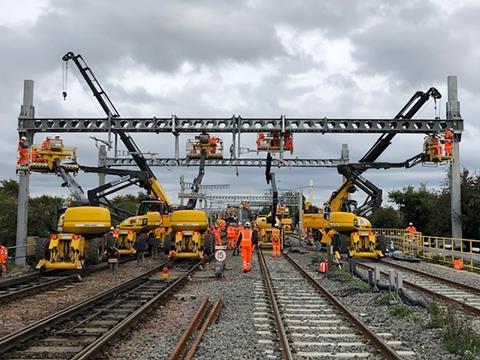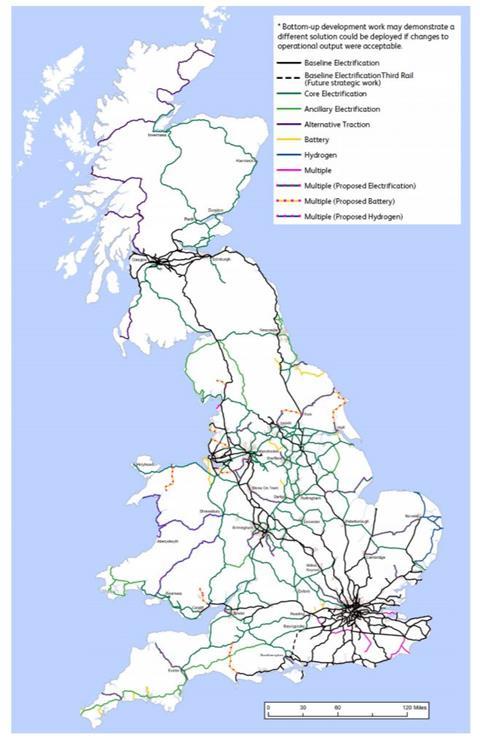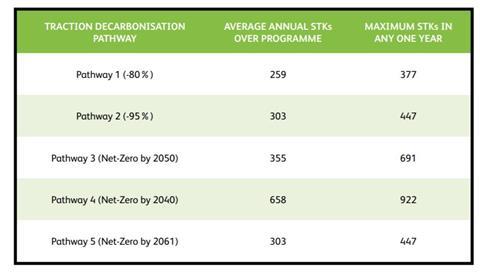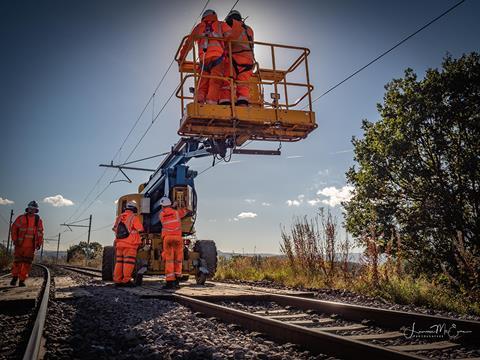
UK: Network Rail has published its interim Traction Decarbonisation Network Strategy, setting out preliminary recommendations for meeting government ambitions to decarbonise the rail network.

The Interim Business Case released on September 10 considers the three main ways of achieving this aim: electrification, batteries and hydrogen fuel cells. Electrification has a high capital cost, but batteries and hydrogen are unsuitable for long-distance high speed and freight services, which have higher energy needs than they can provide.
These technical and cost factors have been used to develop a decision tree to identify the best option for the 15 400 track-km of non-electrified lines in Great Britain.
The strategy recommends electrification of 11 700 track-km, battery operation on 400 km and hydrogen on 900 km.
This leaves 2 400 km where there is no clear technical choice; further operational and economic analysis has recommended another 1 340 km of electrification, 400 km of battery operation and 400 km of hydrogen. No clear decision has yet been made on the remaining 260 km.
The strategy says providing 25 kV 50 Hz overhead on small sections of line linking routes currently electrified using the 750 V DC third rail system ‘does not make operational sense’. Network Rail, safety body RSSB and regulator ORR are currently working to establish the feasibility of providing a ‘modern-day conductor rail’ system for these areas, and expect to report in late 2021. If they conclude that third rail electrification is not possible, then battery operation would be required.

NR says the best way of achieving the decarbonisation targets would be through a long-term, stable and efficient programme of electrification running for at least 30 years.
Five ‘pathways’ have been developed, in order to help funders consider the trade-offs which need to be made around the degree of decarbonisation achieved, speed of delivery and cost.
Rolling stock
Between 3 600 and 3 800 electric and 150 to 200 battery and hydrogen trains would be required, although the need for interim options would increase the number of battery and hydrogen trains needed in the short term.

Around 650 to 700 new freight locomotives will also be required, which are likely to be a mixture of electric and multi-mode vehicles.
The strategy says diesel-only trains should only be bought where there are clear strategic and economic reasons for doing so; these should have the possibility of replacing the engines with zero-carbon alternatives at a later stage.
Clear case for electrification
Railway Industry Association Technical Director David Clarke welcomed the strategy, saying it was ‘very positive, setting out a clear case for the electrification of intensively-used passenger and most freight lines, with the decarbonisation of other routes through zero carbon technologies’.

Pointing out that work to electrify the southern part of the Midland Main Line was now coming to an end, ‘leaving the UK with no electrification projects being delivered on the ground’, he warned that ‘without further work soon, the industry will begin to lose valuable skills and the capacity to deliver these schemes, making it harder to deliver these projects when work resumes.’
Clarke called for the government to support electrification and the deployment of low carbon trains without waiting for the final strategy to be published. ‘There are projects which should be progressed immediately’, he suggested.



